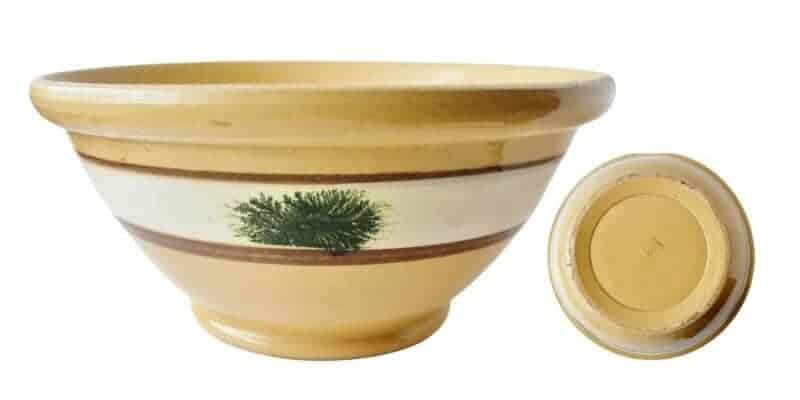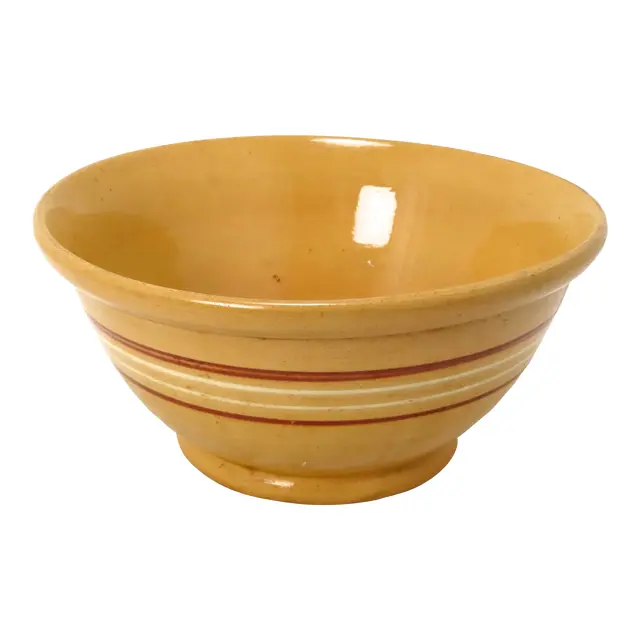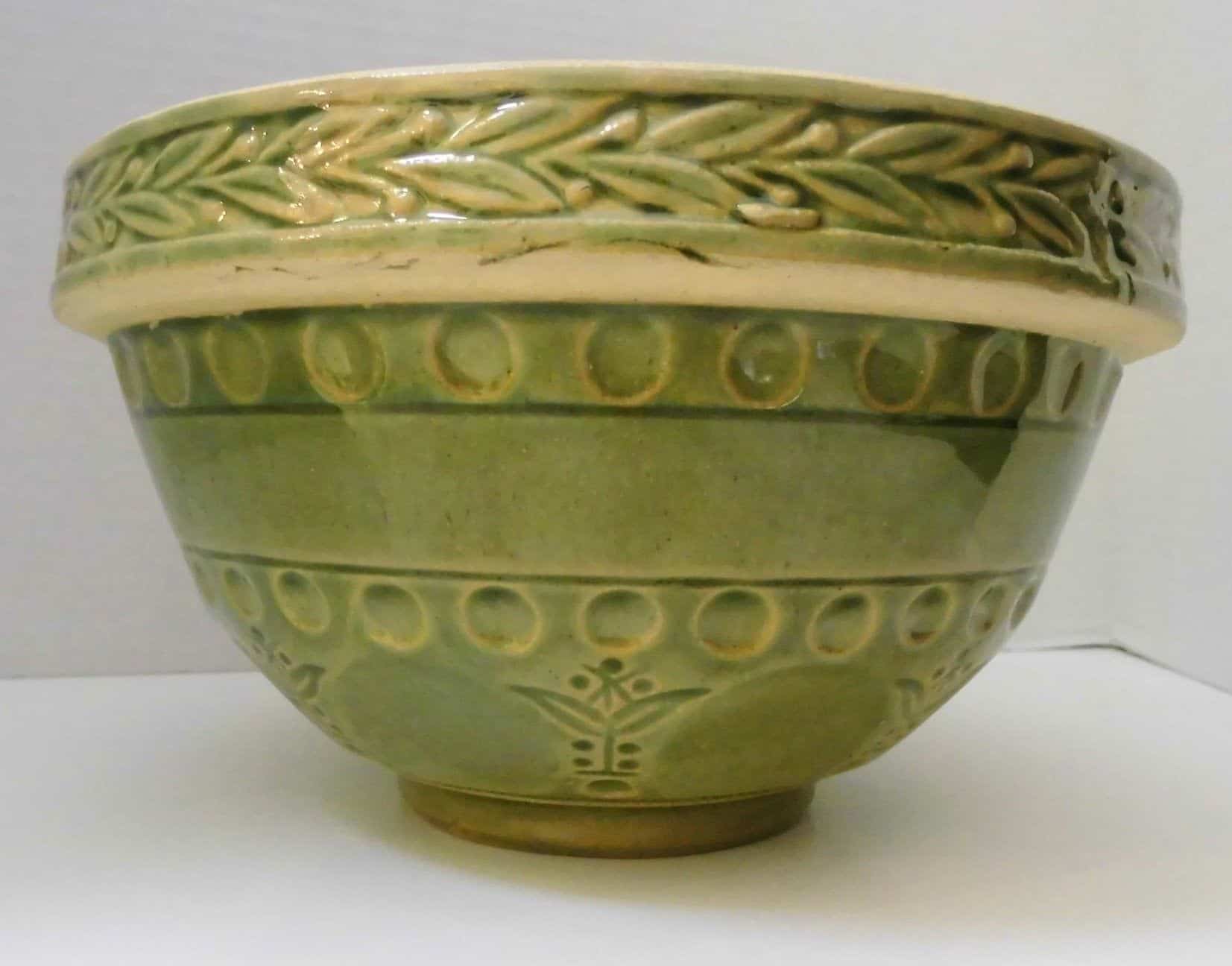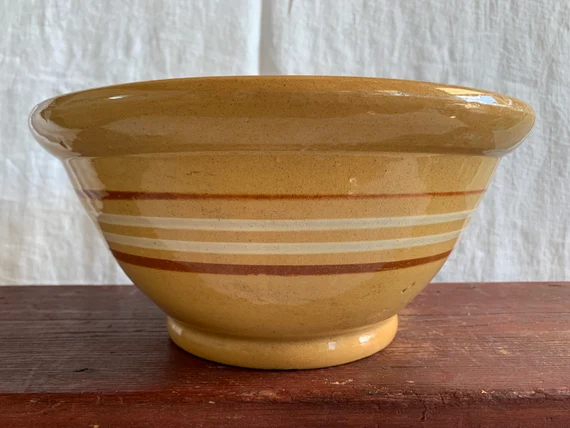Have you ever wondered what people used to eat and store their food before plastic and glass pyrex bowls? The answer is earthenware bowls that were made from different types of clay.
One of the most popular types of earthenware bowls is yellowware bowls. Yellowware bowls are made of a particular type of yellow clay, which gives them their unique color and name.
This article will help you learn more about the history and different styles of yellow ware bowls. It’ll also give you information on the value of yellow ware and how to spot them, and determine their age and origin.
Are you interested in starting a yellowware collection? Maybe you have an old set of yellowware bowls you want to get rid of and make some money?
Keep on reading to find out more about antique yellowware bowls!
Table of Contents
History of Yellow Ware Bowls
The first yellow ware originated in Scotland during the late 18th century. Soon after, production of yellow ware began in England in the areas of Yorkshire and Staffordshire. Yellowware bowls became very popular in England due to their sturdiness and utilitarian aesthetic.
Until the mid-19th century, and more specifically the 1830s, Americans would import all pottery, including yellow ware, from England. But, after people discovered supplies of yellow clay in areas such as New Jersey, Ohio, and Maryland, yellowware production also began in America.
In fact, the native American tribe Hobi crafted a unique type of yellowware called Jeddito Yellow Ware.
The first yellowware bowls would be produced by placing yellow clay on a potter’s wheel and forming it by hand. That’s why some of the earliest yellow ware would have rough shapes or unrefined finishes.
Later, potters started using molds to give better and more uniform shapes. Yellow ware bowls also come in different colorations depending on the color of the clay used. These colors can range from a butter-like light yellow to a deep mustard yellow.
The reason why yellowware became so ubiquitous lies in yellow clay itself. Yellow clay contains a lower iron level, which allows it to vitrify at significantly higher temperatures than other types of clay. This makes yellowware much more durable and sturdy, which is ideal for kitchenware.
Yellow ware retained its popularity beyond the late 1800s and into the early 20th century. Eventually, around the 1940s, people started using more modern materials in kitchenware. Nowadays, it’s not advised to use it for food storage as it can cause lead poisoning.
Types of Yellow Ware Bowls
Generally, yellowware bowls were sold in sets of graduated sizes. Each set contained six to twelve bowls in sizes ranging from 3 to 17 inches in diameter. The rarest and hard-to-find bowls are the small and large bowls in each set.
There are a few distinct characteristics that help categorize yellow ware bowls into different types. These are:
Mold Markings

Since the earlier yellow ware bowls were handmade without molds, they usually lacked decorations, mold marks, or a well-shaped lip. Once potters began using molds, they could decorate their bowls in any way they wished and create different styles of bowls.
They used molds that had specific geometric shapes or floral designs. Also, depicting scenic motifs was a popular way to decorate these bowls.
Bands

Another well-known way to decorate a yellow ware bowl was banding. Potters would add colored bands by pouring dyed clay slips on bowls as they turned the pottery wheel. This would create bands in different sizes and unique motifs.
Different Colors & Items

Despite their name, yellow ware could be made in other colors. Instead of using a clear glaze that would make yellow ware shine, potters could use a colored glaze. This way, they could produce yellow ware in different colors like green, brown, or white.
Finally, yellow ware was not limited to bowls, as several other kitchenware was made from yellow clay. These include pie plates, dishes, pitchers, and jugs.
How Do I Identify Antique Yellow Ware Bowls?
Yellow ware bowls have gathered some attention among collectors over the past few decades. Naturally, since they were so popular, there have been many reproductions of them from modern pottery manufacturers.
If you want to make sure that the yellow ware bowl you inherited from your grandmother is a genuine antique, you need to consider a few factors.
Yellow clay that was used to make yellowware bowls was much sturdier and heat-resistant than other clays like red clay. Therefore, antique yellow ware bowls were very heavy and robust. On the other hand, modern replicas don’t have the bulk and weight of older yellow ware.
Also, during the early stages of yellowware making, potters did not decorate them with any unique shapes or marks. So, if you find an old yellow ware bowl that looks rough without any marks or decorations, it’s almost certainly an antique yellow ware bowl.
Finally, there’s the condition of the item. It’s natural for such old and everyday household items to be battered from daily usage. If you find a bowl that looks like an antique yellowware bowl but is in pristine condition, it’s more than likely a modern replica of an old design.
How to Determine the Age of Yellowware Bowls?
One of the most important parts of collecting yellow ware bowls is being able to determine their age and their origin. That’s because yellow ware was made both in England and America. There are a few different ways to help you determine how old your antique yellow ware is. These are:
Manufacturer Marks
If you find a yellow ware bowl that is stamped with a particular mark at its base, it was most likely made during the mid-19th century or later. This is because up until then, potters would not use molds or any special marks on their pottery.
Also, some of these marks are well-known and can help you pinpoint the exact era or place of origin. A great example is the “USA” marking that all American pottery manufacturers utilized around the time of World War I.
Bands
As we mentioned above, potters would use dyed slips to create colored bands in different patterns. These unique colors were prevalent during different eras. From the mid-1800s until the late 1800s, potters would use brown or white banding on their yellow ware.
Until the 1920s, manufacturers used a combination of blue and brown to create even more unique patterns and shapes. During the 20th century, potters started to use new colors such as pink and mauve to make colored bands.
Colors
Some manufacturers would also use colored glaze to make yellowware bowls in different colors. Besides yellow, green was also prevalent from the early 20th century until the 1940s. English manufacturers would also sometimes produce yellow ware with a white interior.
Decorations
Unique decorations were one of the few things that a manufacturer could use to distinguish its yellow ware from other manufacturers. That’s why some patterns have become synonymous with certain famous brands.
A great example is the very famous yellowware manufacturer McCoy in the United States. McCoy was known for some of the unique patterns it put on its yellow ware. These included the “Sunburst” and the “Morning Glory” pattern. Also, McCoy was the only manufacturer to put a square base on its yellowware bowls.
Mocha Decoration
Another popular type of decoration that was used in yellow ware during the mid-19th century was the “Mocha”. The Mocha was a green seaweed-like pattern that was found in some yellow ware bowls.
To create it, the potter would apply a white band to the bowl before baking it. He would then drop or sponge some tea in the band, and the tea would spread and create a unique pattern that looked like seaweed.
Lip Shapes
Once yellow ware started having rims or lips, their different shapes became a way to distinguish their origin. For example, yellow ware made during the 19th century usually had slim-rolled lips, whereas the ones from the 20th century had less rounded rims or ones with wide collars.
Is Yellow Ware Valuable?
In general, the demand for antique yellow ware is not that high. Additionally, these were everyday household items, so they are very common to find both online and in thrift stores. Therefore, they aren’t the most valuable collectibles, but you can still make some money selling them.
Most yellow ware will cost up to $100 to buy. Some yellow ware pieces that are rarer might cost up to a few hundred dollars. Of course, there are some factors that can affect the value of antique yellow ware. These are:
Condition
Just like any other antique item, the condition of an antique yellow ware is mostly what determines its value. While natural signs of aging, like small chips or cracks, are acceptable -and even desirable- any severe damage to the item will depreciate its value.
That said, since yellow ware is mainly used as decoration, even pieces with excessive damage will sell. After all, you only need one side to be intact to put it on a shelf as decoration.
Also, some collectors might choose to purchase a specific yellow ware in bad condition as a placeholder in their collection. Once they find one in better shape, they will replace the broken one.
Age
When it comes to antique yellow ware and age, the general rule is that the older an item is, the higher its price. Older yellow ware, especially those that were made before the use of molds, are particularly hard to track down and have a high value in the antique market.
Another thing to consider is that the older an item is, the harder it is to find it in good condition. Therefore, if you happen to have a very old yellow ware bowl in good condition, look up its value, as it might be higher than you think.
Color & Design
This is a primarily subjective factor and depends on what the collector wants for a collection. Maybe one collector wants a certain color or a particular design and is willing to pay more for it.
Nevertheless, there are some pieces that are more unique and rare that could fetch higher prices. In particular, the bigger and smaller sizes of bowls in a yellow ware set are usually the rarest and can cost a lot more than other bowl sizes from the same set.
Where to Buy and Sell Yellow Ware?
No matter if you’re a buyer or seller, you won’t have any trouble when dealing in yellow ware. If you prefer to make your sales online, you’ll find plenty of listings on sites like eBay, Etsy, and Craigslist.
Make sure that the sender packs the yellow ware with additional padding to prevent any cracks or chips. Consider picking it up yourself if you can to avoid any problems with shipping.
If you want to buy yellow ware in person, you can usually find some in local antique stores, flea markets, local auctions, and even yard sales. There are a lot of people who are looking to get rid of old kitchenware, and you might find some bargains.
Conclusion
Overall, a collection of yellow ware bowls can be a great way to decorate your shelves. Their warm yellow tones add a cozy feeling to your home. Don’t forget that you should only use these items as decoration and not store or consume food.
This is because the glaze that is used to keep them shiny contains lead. So, if you find a yellow ware bowl that has even the smallest chips or cracks, avoid consuming food from it, so you don’t have to deal with any lead poisoning.
Other than that, if their aesthetic interests you, have a look online or even take the time to visit a local antique store. You never know what hidden treasures you may find!
